Afghanistan
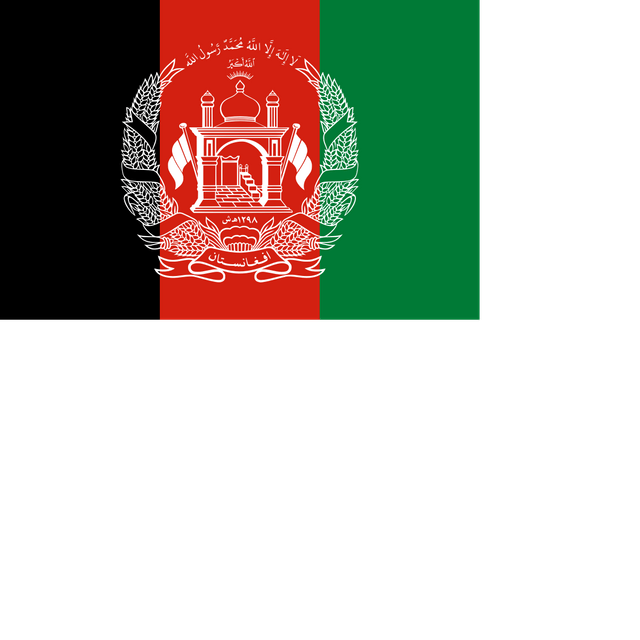
Afghanistan

Islamic Republic of Afghanistan
| |
|---|---|
Motto:لا إله إلا الله، محمد رسول الله "Lā ʾilāha ʾillā llāh, Muhammadun rasūlu llāh" "There is no God but Allah; Muhammad is the messenger of Allah. (Shahada) | |
Anthem:*Millī Surūd ملي سرود (English:"National Anthem") | |
 | |
| Capital and largest city | Kabul 33°N 65°E [333] |
| Official languages |
|
| Ethnic groups | |
| Religion |
|
| Demonym(s) | Afghan[3] Afghanistani[4] |
| Government | Unitary presidential Islamic republic |
• President | Ashraf Ghani |
• 1st Vice President | Abdul Rashid Dostum |
• 2nd Vice President | Sarwar Danish |
• Chief Executive Officer | Abdullah Abdullah |
| Legislature | National Assembly |
• Upper house | House of Elders |
• Lower house | House of the People |
| Formation | |
• Hotak Empire | 21 April 1709 |
• Durrani Empire | October 1747 |
• Emirate | 1823 |
• Recognized | 19 August 1919 |
• Kingdom | 9 June 1926 |
• Republic | 17 July 1973 |
• Current constitution | 26 January 2004 |
| Area | |
• Total | 652,230[5] km2(251,830 sq mi) (40th) |
• Water (%) | negligible |
| Population | |
• 2019 estimate | 32,225,560[6] (44th) |
• Density | 46/km2(119.1/sq mi) (174th) |
| GDP(PPP) | 2018 estimate |
• Total | $72.911 billion[7] (96th) |
• Per capita | $2,024[7] (169th) |
| GDP(nominal) | 2018 estimate |
• Total | $21.657 billion[7] (111st) |
• Per capita | $601[7] (177th) |
| Gini(2008) | low · 1st |
| HDI(2017) | low · 168th |
| Currency | Afghani (Afs) (AFN) |
| Time zone | UTC+4:30 Solar Calendar(D†) |
| Driving side | right |
| Calling code | +93 |
| ISO 3166 code | AF |
| Internet TLD | .af افغانستان. |
Afghanistan (/æfˈɡænɪstæn, æfˈɡɑːnɪstɑːn/ (listen); Pashto/Dari: افغانستان, Pashto: Afġānistān [avɣɒnisˈtɒn, ab-],[10] Dari: Afġānestān [avɣɒnesˈtɒn]), officially the Islamic Republic of Afghanistan, is a landlocked country located in South-Central Asia.[11][5][12] Afghanistan is bordered by Pakistan in the south and east; Iran in the west; Turkmenistan, Uzbekistan, and Tajikistan in the north; and in the far northeast, China. Much of its 652,000 square kilometers (252,000 sq mi) is covered by the Hindu Kush mountain range at the western end of the Himalayas,[13][14] separating the Amu Darya and Indus valleys.[15] Kabul is the capital and largest city.
Human habitation in Afghanistan dates back to the Middle Paleolithic Era, and the country's strategic location along the Silk Road connected it to the cultures of the Middle East and other parts of Asia. The land has historically been home to various peoples and has witnessed numerous military campaigns, including those by Alexander the Great, Mauryas, Muslim Arabs, Mongols, Sikhs, British, Soviets, and since 2001 by the United States with NATO-allied countries. It has been called "unconquerable"[16][17] and nicknamed the "graveyard of empires,"[18] though it has been occupied during several different periods of its history. The land also served as the source from which the Kushans, Hephthalites, Samanids, Saffarids, Ghaznavids, Ghorids, Khaljis, Mughals, Hotaks, Durranis, and others have risen to form major empires.[19]
The political history of the modern state of Afghanistan began with the Hotak and Durrani dynasties in the 18th century. In the late 19th century, Afghanistan became a buffer state in the "Great Game" between British India and the Russian Empire. Its border with British India, the Durand Line, was formed in 1893 but it is not recognized by the Afghan government and it has led to strained relations with Pakistan since the latter's independence in 1947. Following the Third Anglo-Afghan War in 1919 the country was free of foreign influence, eventually becoming a monarchy under King Amanullah, until almost 50 years later when Zahir Shah was overthrown and a republic was established. In 1978, after a second coup Afghanistan first became a socialist state and then a Soviet Union protectorate. This evoked the Soviet–Afghan War in the 1980s against mujahideen rebels. By 1996 most of Afghanistan was captured by the Islamic fundamentalist group the Taliban, who ruled most of the country as a totalitarian regime for over five years. The Taliban were forcibly removed by the NATO-led coalition, and a new democratically-elected government political structure was formed, but they still control a significant portion of the country.[20]
Afghanistan is a unitary presidential Islamic republic with a population of 31 million, mostly composed of ethnic Pashtuns, Tajiks, Hazaras and Uzbeks. The country continues to face severe problems, including Taliban insurgency, terrorism, poverty, child malnutrition, and corruption.[21][22][23][24] Islam is the state religion of Afghanistan. It is a member of the United Nations, the Organisation of Islamic Cooperation, the Group of 77, the Economic Cooperation Organization, and the Non-Aligned Movement. Afghanistan's economy is the world's 96th largest, with a GDP of $72.9 billion by purchasing power parity; the country fares much worse in terms of per-capita GDP (PPP), ranking 169th out of 186 countries as of 2018.[7]
Islamic Republic of Afghanistan
| |
|---|---|
Motto:لا إله إلا الله، محمد رسول الله "Lā ʾilāha ʾillā llāh, Muhammadun rasūlu llāh" "There is no God but Allah; Muhammad is the messenger of Allah. (Shahada) | |
Anthem:*Millī Surūd ملي سرود (English:"National Anthem") | |
 | |
| Capital and largest city | Kabul 33°N 65°E [333] |
| Official languages |
|
| Ethnic groups | |
| Religion |
|
| Demonym(s) | Afghan[3] Afghanistani[4] |
| Government | Unitary presidential Islamic republic |
• President | Ashraf Ghani |
• 1st Vice President | Abdul Rashid Dostum |
• 2nd Vice President | Sarwar Danish |
• Chief Executive Officer | Abdullah Abdullah |
| Legislature | National Assembly |
• Upper house | House of Elders |
• Lower house | House of the People |
| Formation | |
• Hotak Empire | 21 April 1709 |
• Durrani Empire | October 1747 |
• Emirate | 1823 |
• Recognized | 19 August 1919 |
• Kingdom | 9 June 1926 |
• Republic | 17 July 1973 |
• Current constitution | 26 January 2004 |
| Area | |
• Total | 652,230[5] km2(251,830 sq mi) (40th) |
• Water (%) | negligible |
| Population | |
• 2019 estimate | 32,225,560[6] (44th) |
• Density | 46/km2(119.1/sq mi) (174th) |
| GDP(PPP) | 2018 estimate |
• Total | $72.911 billion[7] (96th) |
• Per capita | $2,024[7] (169th) |
| GDP(nominal) | 2018 estimate |
• Total | $21.657 billion[7] (111st) |
• Per capita | $601[7] (177th) |
| Gini(2008) | low · 1st |
| HDI(2017) | low · 168th |
| Currency | Afghani (Afs) (AFN) |
| Time zone | UTC+4:30 Solar Calendar(D†) |
| Driving side | right |
| Calling code | +93 |
| ISO 3166 code | AF |
| Internet TLD | .af افغانستان. |
Etymology
The name Afghānistān (Pashto: افغانستان) is believed to be as old as the ethnonym Afghan, which is documented in the 10th-century geography book Hudud ul-'alam.[25] The root name "Afghan" was used historically in reference to a member of the ethnic Pashtuns,[26] and the suffix "-stan" means "place of" in Persian. Therefore, Afghanistan translates to land of the Afghans[27] or, more specifically in a historical sense, to land of the Pashtuns. However, the modern Constitution of Afghanistan states that "[t]he word Afghan shall apply to every citizen of Afghanistan."[28]
History
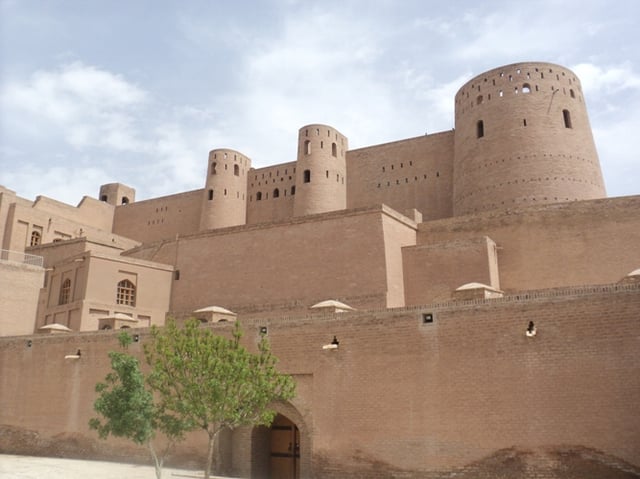
Citadel of Herat
Excavations of prehistoric sites suggest that humans were living in what is now Afghanistan at least 50,000 years ago, and that farming communities in the area were among the earliest in the world. An important site of early historical activities, many believe that Afghanistan compares to Egypt in terms of the historical value of its archaeological sites.[29][30]
The country sits at a unique nexus point where numerous civilizations have interacted and often fought. It has been home to various peoples through the ages, among them the ancient Iranian peoples who established the dominant role of Indo-Iranian languages in the region. At multiple points, the land has been incorporated within vast regional empires, among them the Achaemenid Empire, the Macedonian Empire, the Indian Maurya Empire, and the Islamic Empire.[31]
Many empires and kingdoms have also risen to power in Afghanistan, such as the Greco-Bactrians, Kushans, Hephthalites, Kabul Shahis, Saffarids, Samanids, Ghaznavids, Ghurids, Khaljis, Kartids, Timurids, Mughals, and finally the Hotak and Durrani dynasties that marked the political origins of the modern state.[32]
Pre-Islamic period

Bilingual (Greek and Aramaic) edict by Emperor Ashoka from the 3rd century BCE discovered in the southern city of Kandahar
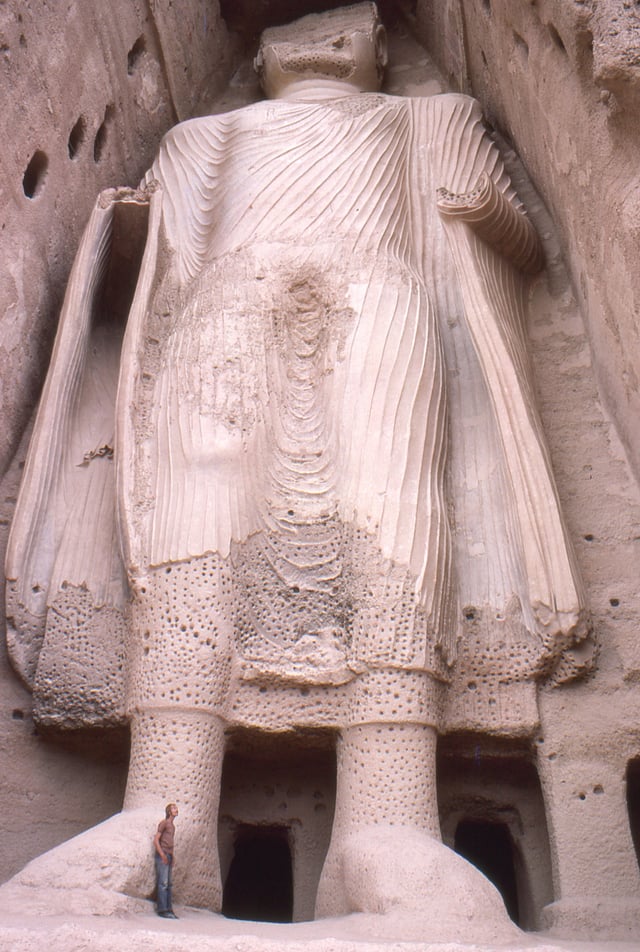
The smaller Buddha.
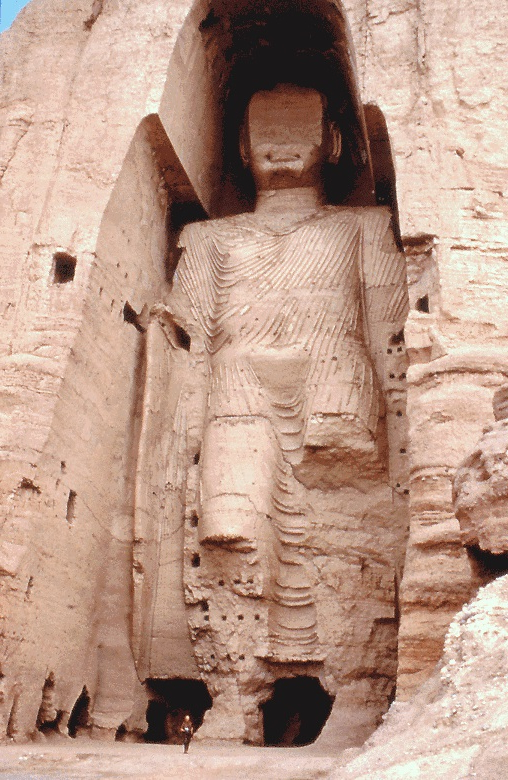
The taller Buddha of Bamiyan. Buddhism was widespread before the Islamic conquest of Afghanistan.
Archaeological exploration done in the 20th century suggests that the geographical area of Afghanistan has been closely connected by culture and trade with its neighbors to the east, west, and north. Artifacts typical of the Paleolithic, Mesolithic, Neolithic, Bronze, and Iron ages have been found in Afghanistan. Urban civilization is believed to have begun as early as 3000 BCE, and the early city of Mundigak (near Kandahar in the south of the country) may have been a colony of the nearby Indus Valley Civilization. More recent findings established that the Indus Valley Civilisation stretched up towards modern-day Afghanistan, making the ancient civilization today part of Pakistan, Afghanistan, and India. In more detail, it extended from what today is northwest Pakistan to northwest India and northeast Afghanistan. An Indus Valley site has been found on the Oxus River at Shortugai in northern Afghanistan.[33][34] There are several smaller IVC colonies to be found in Afghanistan as well.
After 2000 BCE, successive waves of semi-nomadic people from Central Asia began moving south into Afghanistan; among them were many Indo-European-speaking Indo-Iranians. These tribes later migrated further into South Asia, Western Asia, and toward Europe via the area north of the Caspian Sea. The region at the time was referred to as Ariana.[29][35]
The religion Zoroastrianism is believed by some to have originated in what is now Afghanistan between 1800 and 800 BCE, as its founder Zoroaster is thought to have lived and died in Balkh. Ancient Eastern Iranian languages may have been spoken in the region around the time of the rise of Zoroastrianism. By the middle of the 6th century BCE, the Achaemenids overthrew the Medes and incorporated Arachosia, Aria, and Bactria within its eastern boundaries. An inscription on the tombstone of Darius I of Persia mentions the Kabul Valley in a list of the 29 countries that he had conquered.[36]
Alexander the Great and his Macedonian forces arrived in Afghanistan in 330 BCE after defeating Darius III of Persia a year earlier in the Battle of Gaugamela. Following Alexander's brief occupation, the successor state of the Seleucid Empire controlled the region until 305 BCE when they gave much of it to the Maurya Empire as part of an alliance treaty. The Mauryans controlled the area south of the Hindu Kush until they were overthrown in about 185 BCE. Their decline began 60 years after Ashoka's rule ended, leading to the Hellenistic reconquest by the Greco-Bactrians. Much of it soon broke away from them and became part of the Indo-Greek Kingdom. They were defeated and expelled by the Indo-Scythians in the late 2nd century BCE.[2][37]
During the first century BCE, the Parthian Empire subjugated the region but lost it to their Indo-Parthian vassals. In the mid-to-late first century CE the vast Kushan Empire, centered in Afghanistan, became great patrons of Buddhist culture, making Buddhism flourish throughout the region. The Kushans were overthrown by the Sassanids in the 3rd century CE, though the Indo-Sassanids continued to rule at least parts of the region. They were followed by the Kidarite who, in turn, were replaced by the Hephthalites. By the 6th century CE, the successors to the Kushans and Hepthalites established occupied the Gandhara region and became Indianized and adopted Hinduism. They were replaced by the Turk Shahi in the 7th century. The Buddhist Turk Shahi of Kabul was replaced by a Hindu dynasty before the Saffarids conquered the area in 870, this Hindu dynasty was called Hindu Shahi. Much of the northeastern and southern areas of the country remained dominated by Buddhist and Hindu culture.[38][39][40]
Islamization and Mongol invasion
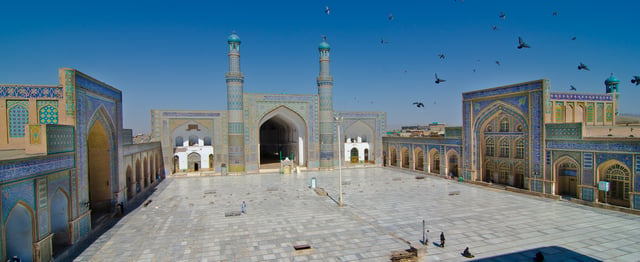
The Friday Mosque of Herat is one of the oldest mosques in Afghanistan
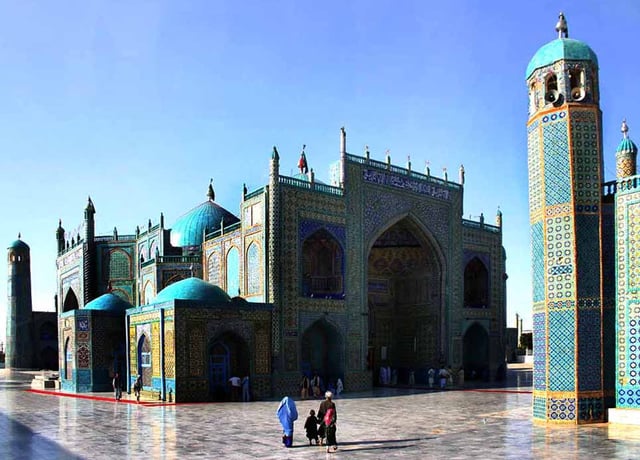
The Blue Mosque in Mazar-i-Sharif was built in the 15th century
Arab Muslims brought Islam to Herat and Zaranj in 642 CE and began spreading eastward; some of the native inhabitants they encountered accepted it while others revolted. Before Islam was introduced, people of the region were mostly Buddhists and Zoroastrians, but there were also Surya and Nana worshipers, Jews, and others. The Zunbils and Kabul Shahi were first conquered in 870 CE by the Saffarid Muslims of Zaranj. Later, the Samanids extended their Islamic influence south of the Hindu Kush. It is reported that Muslims and non-Muslims still lived side by side in Kabul before the Ghaznavids rose to power in the 10th century.[41][42][43]
By the 11th century, Mahmud of Ghazni defeated the remaining Hindu rulers and effectively Islamized the wider region,[44] with the exception of Kafiristan.[45] Mahmud made Ghazni into an important city and patronized intellectuals such as the historian Al-Biruni and the poet Ferdowsi.[46] The Ghaznavid dynasty was overthrown by the Ghurids, whose architectural achievements included the remote Minaret of Jam. The Ghurids controlled Afghanistan for less than a century before being conquered by the Khwarazmian dynasty in 1215.[47]
In 1219 AD, Genghis Khan and his Mongol army overran the region. His troops are said to have annihilated the Khorasanian cities of Herat and Balkh as well as Bamyan.[48] The destruction caused by the Mongols forced many locals to return to an agrarian rural society.[49] Mongol rule continued with the Ilkhanate in the northwest while the Khalji dynasty administered the Afghan tribal areas south of the Hindu Kush until the invasion of Timur, who established the Timurid Empire in 1370.
In the early 16th century, Babur arrived from Fergana and captured Kabul from the Arghun dynasty. In 1526, he invaded Delhi in India to replace the Lodi dynasty with the Mughal Empire. Between the 16th and 18th century, the Khanate of Bukhara, Safavids, and Mughals ruled parts of the territory. Before the 19th century, the northwestern area of Afghanistan was referred to by the regional name Khorasan. Two of the four capitals of Khorasan (Herat and Balkh) are now located in Afghanistan, while the regions of Kandahar, Zabulistan, Ghazni, Kabulistan, and Afghanistan formed the frontier between Khorasan and Hindustan.[50][51][52]
Hotak dynasty and Durrani Empire
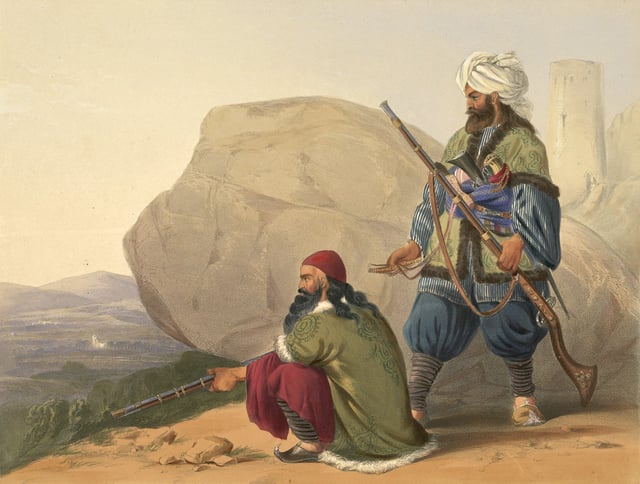
Afghan tribesmen in 1841, painted by British officer James Rattray
In 1709, Mirwais Hotak, a local Ghilzai tribal leader, successfully rebelled against the Safavids. He defeated Gurgin Khan and made Afghanistan independent.[53] Mirwais died of natural causes in 1715 and was succeeded by his brother Abdul Aziz, who was soon killed by Mirwais' son Mahmud for treason. Mahmud led the Afghan army in 1722 to the Persian capital of Isfahan, captured the city after the Battle of Gulnabad and proclaimed himself King of Persia.[53] The Afghan dynasty was ousted from Persia by Nader Shah after the 1729 Battle of Damghan.
In 1738, Nader Shah and his forces captured Kandahar, the last Hotak stronghold, from Shah Hussain Hotak, at which point the incarcerated 16-year-old Ahmad Shah Durrani was freed and made the commander of an Afghan regiment. Soon after the Persian and Afghan forces invaded India. By 1747, the Afghans chose Durrani as their head of state.[54] Durrani and his Afghan army conquered much of present-day Afghanistan, Pakistan, the Khorasan and Kohistan provinces of Iran, and Delhi in India.[55] He defeated the Indian Maratha Empire, and one of his biggest victories was the 1761 Battle of Panipat.
In October 1772, Durrani died of natural causes and was buried at a site now adjacent to the Shrine of the Cloak in Kandahar. He was succeeded by his son, Timur Shah, who transferred the capital of Afghanistan from Kandahar to Kabul in 1776. After Timur's death in 1793, the Durrani throne passed down to his son Zaman Shah, followed by Mahmud Shah, Shuja Shah and others.[56]
By the early 19th century, the Afghan empire was under threat from the Persians in the west and the Sikh Empire in the east. Fateh Khan, leader of the Barakzai tribe, had installed 21 of his brothers in positions of power throughout the empire. After his death, they rebelled and divided up the provinces of the empire between themselves. During this turbulent period, Afghanistan had many temporary rulers until Dost Mohammad Khan declared himself emir in 1826.[57] The Punjab region was lost to Ranjit Singh, who invaded Khyber Pakhtunkhwa and in 1834 captured the city of Peshawar.[58] In 1837, during the Battle of Jamrud near the Khyber Pass, Akbar Khan and the Afghan army failed to capture the Jamrud fort from the Sikh Khalsa Army, but killed Sikh Commander Hari Singh Nalwa, thus ending the Afghan-Sikh Wars. By this time the British were advancing from the east and the first major conflict during "The Great Game" was initiated.[59]
British influence and independent kingdom
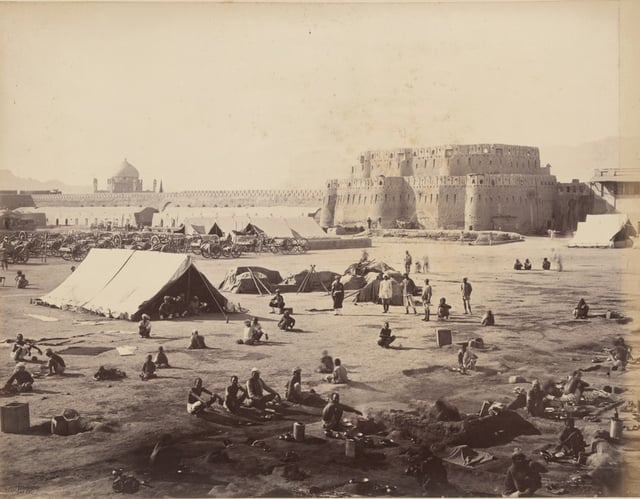
British and allied forces at Kandahar after the 1880 Battle of Kandahar, during the Second Anglo-Afghan War. The large defensive wall around the city was removed in the early 1930s by order of King Nadir.
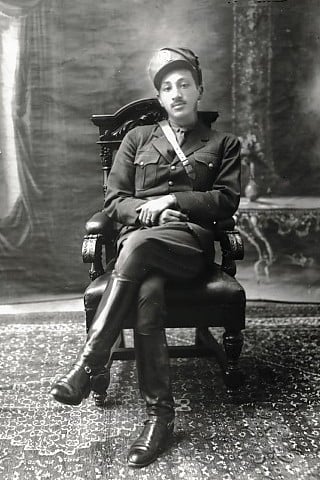
Zahir Shah, the last king of Afghanistan, who reigned from 1933 to 1973.
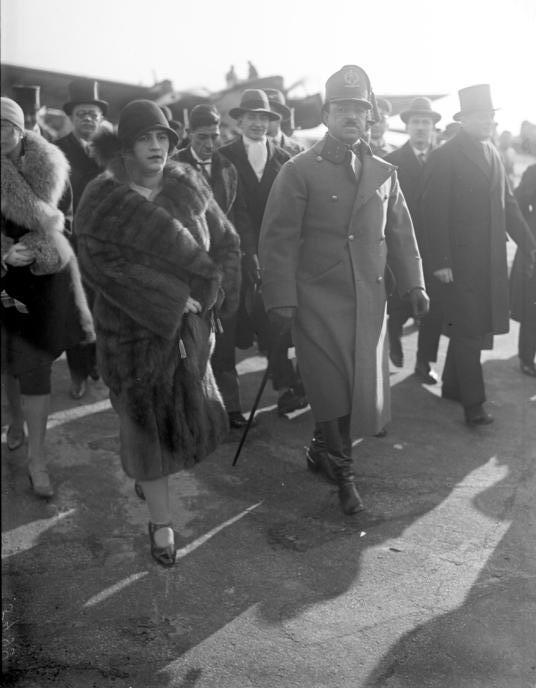
King Amanullah Khan and Queen Soraya Tarzi on a visit to Berlin in 1928
In 1838, the British marched into Afghanistan and arrested Dost Mohammad, sent him into exile in India and replaced him with the previous ruler, Shah Shuja.[60][61] Following an uprising, the 1842 retreat from Kabul of British-Indian forces and the annihilation of Elphinstone's army, and the Battle of Kabul that led to its recapture, the British placed Dost Mohammad Khan back into power and withdrew their military forces from Afghanistan. In 1878, the Second Anglo-Afghan War was fought over perceived Russian influence, Abdur Rahman Khan replaced Ayub Khan, and Britain gained control of Afghanistan's foreign relations as part of the Treaty of Gandamak of 1879. In 1893, Mortimer Durand made Amir Abdur Rahman Khan sign a controversial agreement in which the ethnic Pashtun and Baloch territories were divided by the Durand Line. This was a standard divide and rule policy of the British and would lead to strained relations, especially with the later new state of Pakistan. Shia-dominated Hazarajat and pagan Kafiristan remained politically independent until being conquered by Abdur Rahman Khan in 1891–1896.
After the Third Anglo-Afghan War and the signing of the Treaty of Rawalpindi on 19 August 1919, King Amanullah Khan declared Afghanistan a sovereign and fully independent state. He moved to end his country's traditional isolation by establishing diplomatic relations with the international community and, following a 1927–28 tour of Europe and Turkey, introduced several reforms intended to modernize his nation. A key force behind these reforms was Mahmud Tarzi, an ardent supporter of the education of women. He fought for Article 68 of Afghanistan's 1923 constitution, which made elementary education compulsory. The institution of slavery was abolished in 1923.[62]
Some of the reforms that were put in place, such as the abolition of the traditional burqa for women and the opening of several co-educational schools, quickly alienated many tribal and religious leaders, and this led to the Afghan Civil War (1928–1929). Faced with the overwhelming armed opposition, Amanullah Khan abdicated in January 1929, and soon after Kabul fell to Saqqawist forces led by Habibullah Kalakani.[63] Prince Mohammed Nadir Shah, Amanullah's cousin, in turn defeated and killed Kalakani in October 1929, and was declared King Nadir Shah.[64] He abandoned the reforms of Amanullah Khan in favor of a more gradual approach to modernization but was assassinated in 1933 by Abdul Khaliq, a fifteen-year-old Hazara student.[65]
Mohammed Zahir Shah, Nadir Shah's 19-year-old son, succeeded to the throne and reigned from 1933 to 1973. Until 1946, Zahir Shah ruled with the assistance of his uncle, who held the post of Prime Minister and continued the policies of Nadir Shah. Another of Zahir Shah's uncles, Shah Mahmud Khan, became Prime Minister in 1946 and began an experiment allowing greater political freedom, but reversed the policy when it went further than he expected. He was replaced in 1953 by Mohammed Daoud Khan, the king's cousin and brother-in-law, and a Pashtun nationalist who sought the creation of a Pashtunistan, leading to highly tense relations with Pakistan.[66] During his ten years at the post until 1963, Daoud Khan pressed for social modernization reforms and sought a closer relationship with the Soviet Union. Afterward, the 1964 constitution was formed, and the first non-royal Prime Minister was sworn in.[67]
King Zahir Shah, like his father Nadir Shah, had a policy of maintaining national independence while pursuing gradual modernization, creating nationalist feeling, and improving relations with the United Kingdom. Close relations with the Muslim states Turkey, the Kingdom of Iraq and Iran/Persia were also pursued, while further international relations were sought by joining the League of Nations in 1934. The 1930s saw the development of roads, infrastructure, the founding of a national bank, and increased education. Road links in the north played a large part in a growing cotton and textile industry.[67] The country built close relationships with the Axis powers, with Germany having the largest share in Afghan development at the time.[68] However, Afghanistan remained neutral and was neither a participant in World War II nor aligned with either power bloc in the Cold War thereafter. However, it was a beneficiary of the latter rivalry as both the Soviet Union and the United States vied for influence by building Afghanistan's main highways, airports, and other vital infrastructure. On a per capita basis, Afghanistan received more Soviet development aid than any other country. Afghanistan had, therefore, good relations with both Cold War enemies. In 1973, while the King was on an official overseas visit, Daoud Khan launched a bloodless coup and became the first President of Afghanistan, abolishing the monarchy. In the meantime, Zulfikar Ali Bhutto got neighboring Pakistan involved in Afghanistan. Some experts suggest that Bhutto paved the way for the April 1978 Saur Revolution.[69]
PDPA coup d'état and Soviet war
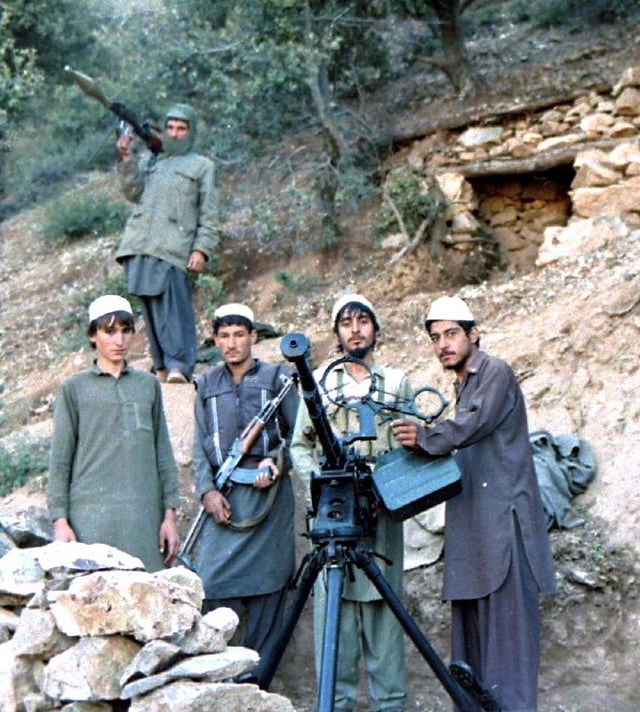
Hezb-i Islami Khalis fighters in the Sultan Valley of Kunar Province, 1987
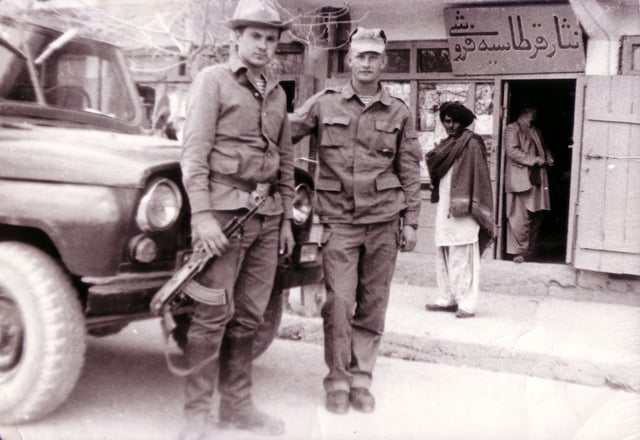
Soviet troops in Gardez, Afghanistan in 1987
In April 1978, the People's Democratic Party of Afghanistan (PDPA) seized power in the Saur Revolution, a coup d'état against then-President Mohammed Daoud Khan. The PDPA declared the establishment of the Democratic Republic of Afghanistan, with its first President named as Nur Muhammad Taraki.[70]
Opposition to PDPA reforms, such as its land redistribution policy and modernization of civil and marriage laws, led to unrest which became an open revolt by October 1978, first in eastern Afghanistan. That uprising quickly expanded into a civil war waged by guerrilla mujahideen against regime forces countrywide. The Pakistani government provided these rebels with covert training centers, while the Soviet Union sent thousands of military advisers to support the PDPA regime.[71] The United States supported Afghan mujahideen and foreign "Afghan Arab" fighters through Pakistan's Inter-Services Intelligence (ISI).[72]
Meanwhile, increasing friction between the competing factions of the PDPA — the dominant Khalq and the more moderate Parcham — resulted (in July–August 1979) in the dismissal of Parchami cabinet members and the arrest of Parchami military officers under the pretext of a Parchami coup.[73]
In September 1979, President Taraki was assassinated in a coup within the PDPA orchestrated by fellow Khalq member Hafizullah Amin, who assumed the presidency. The situation in the country deteriorated under Amin and thousands of people went missing.[74] The Soviet Union was displeased with Amin's government and decided to intervene and invade the country on 27 December 1979, killing Amin that same day.[75]
A Soviet-organized regime, led by Parcham's Babrak Karmal but inclusive of both factions (Parcham and Khalq), filled the vacuum. Soviet troops in more substantial numbers were deployed to stabilize Afghanistan under Karmal, marking the beginning of the Soviet–Afghan War.[76] The United States continued to support the mujahideen through Pakistan's ISI[72] and Saudi Arabia, delivering billions of dollars in cash and weapons including two thousand FIM-92 Stinger surface-to-air missiles.[77][78]
The war lasted until 1989. Soviet forces, their Afghan proxies and rebels killed between 562,000[79] and 2 million Afghans,[80][81][82][83][84][85][86] and displaced about 6 million people who subsequently fled Afghanistan, mainly to Pakistan and Iran.[87] Many countryside villages were bombed and some cities such as Herat and Kandahar were also damaged from air bombardment. Pakistan's North-West Frontier Province functioned as an organisational and networking base for the anti-Soviet Afghan resistance, with the province's influential Deobandi ulama playing a major supporting role in promoting the 'jihad'.[88]
Faced with mounting international pressure and numerous casualties, the Soviets withdrew from Afghanistan in 1989, but continued to support Afghan President Mohammad Najibullah until 1992.[89]
Proxy and civil war and Islamic jihad 1989–96

Development of the civil war from 1992 to late 2001

A section of Kabul during the civil war in 1993, which caused significant damage to the capital
After the Soviet withdrawal, the conflict between the mujahideen and the PDPA continued.[90] President Najibullah, who had become president in 1987, tried to build support for his government by moving away from socialism to pan-Afghan nationalism and portraying his government as Islamic.[91]
Nevertheless, Najibullah did not win any significant support. In March 1989, mujahideen groups launched an attack on Jalalabad, instigated by the Pakistani ISI, but the attack failed.[92] With the dissolution of the Soviet Union in December 1991 and the ending of Russian support, President Najibullah was left without foreign aid. In March 1991, mujahideen forces attacked and conquered the city of Khost.
In March 1992, President Najibullah agreed to step aside and make way for a mujahideen coalition government. At this time there were seven main mujahideen groups: Hezb-e Islami (Gulbuddin faction), Hezb-e Islami (Khalis faction), Jamiat-e Islami, Islamic Dawah Organisation of Afghanistan, the National Islamic Front for Afghanistan, the National Liberation Front, and the Islamic Revolution Movement . Their leaders came together in Peshawar, Pakistan, to negotiate a coalition government, but Hezbi Islami's leader Gulbuddin Hekmatyar refused to confer and instead invaded Kabul. This kicked off a civil war, starting 25 April 1992, between initially three, but within weeks five or six mujahideen groups.[93][94][95] Kabul was heavily bombarded and partially destroyed by the fighting.[96]
As the war continued in 1993–95, the mujahideen committed widespread rape, murder and extortion.[94][97][96] In January–June 1994, 25,000 people died in Kabul due to fighting between an alliance of Abdul Rashid Dostum's Junbish with Hekmatyar's Hezbi Islami against Ahmad Shah Massoud's Jamiat forces.[98] The Taliban emerged in September 1994 as a movement and militia of Pashtun students (talib) from Islamic madrassas (schools) in Pakistan,[96][99] pledged to rid Afghanistan of 'warlords and criminals',[100] and soon had military support from Pakistan.[101] In November 1994 the Taliban took control of Kandahar city after forcing out local Pashtun leaders.[96] The Taliban in early 1995 attempted to capture Kabul but were repelled by forces under Massoud. The Taliban grew stronger and in September 1996 attacked and occupied Kabul after Massoud and Hekmatyar had withdrawn their troops from the city.[102][103]
Taliban Emirate and Northern Alliance
In late September 1996, the Taliban, in control of Kabul and most of Afghanistan,[104] proclaimed the Islamic Emirate of Afghanistan. The Taliban were condemned internationally for the harsh enforcement of their interpretation of Islamic sharia law, which resulted in the brutal treatment of many Afghans, especially women.[105][106] During their rule, the Taliban and their allies committed massacres against Afghan civilians, denied UN food supplies to 160,000 starving civilians and conducted a policy of scorched earth, burning vast areas of fertile land and destroying tens of thousands of homes.[107][108][109][110][111][112]
After the fall of Kabul to the Taliban, Massoud and Dostum formed the Northern Alliance. The Taliban defeated Dostum's forces during the Battles of Mazar-i-Sharif (1997–98). Pakistan's Chief of Army Staff, Pervez Musharraf, began sending thousands of Pakistanis to help the Taliban defeat the Northern Alliance.[113][101][114][115][116] From 1996 to 2001, the al-Qaeda network of Osama bin Laden and Ayman al-Zawahiri was also operating inside Afghanistan.[117] Around 400,000 Afghans died in internal conflicts between 1990 and 2001.[118]
On 9 September 2001, Massoud was assassinated by two Arab suicide attackers in Panjshir province. Two days later, the September 11 attacks were carried out in the United States. The US government suspected Osama bin Laden as the perpetrator of the attacks, and demanded that the Taliban hand him over.[119] The Taliban offered to hand over Bin Laden to a third country for trial, but not directly to the US. Washington refused that offer.[120] Instead, the US launched the October 2001 Operation Enduring Freedom. The majority of Afghans supported the American invasion of their country.[121][122] During the initial invasion, US and UK forces bombed al-Qaeda training camps. Working with the Northern Alliance, the US removed the Taliban from power.[123]
Recent history (2002–present)
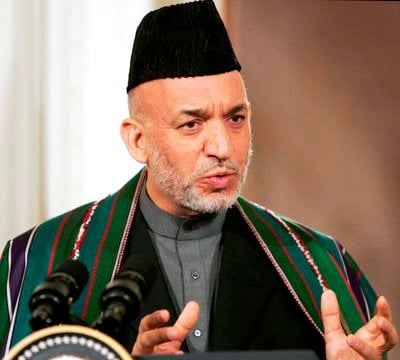
Hamid Karzai dominated Afghan politics after the Taliban's fall
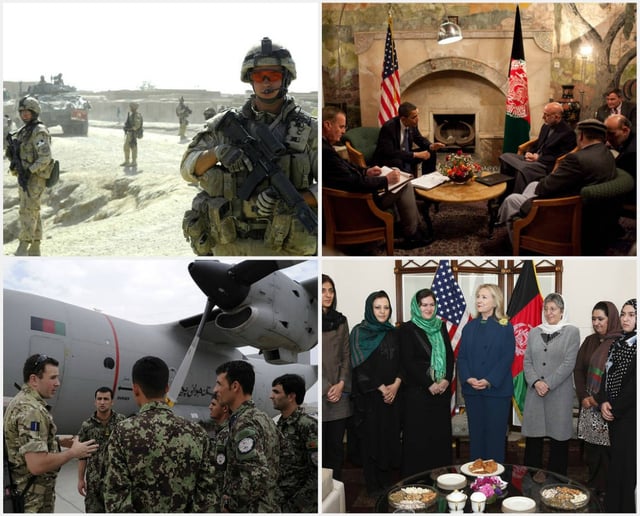
From upper left, clockwise – Canadian troops in Kandahar; American president Barack Obama meets Afghan leader Hamid Karzai in March 2010; US Secretary of State Hillary Clinton with female politicians in Kabul in October 2011; An officer of the RAF explains a C-27 of the Afghan air force to 'Thunder Lab' students in July 2011
In December 2001, after the Taliban government was overthrown, the Afghan Interim Administration under Hamid Karzai was formed. The International Security Assistance Force (ISAF) was established by the UN Security Council to help assist the Karzai administration and provide basic security.[124][125] Taliban forces meanwhile began regrouping inside Pakistan, while more coalition troops entered Afghanistan and began rebuilding the war-torn country.[126][127]
Shortly after their fall from power, the Taliban began an insurgency to regain control of Afghanistan. Over the next decade, ISAF and Afghan troops led many offensives against the Taliban, but failed to fully defeat them. Afghanistan remains one of the poorest countries in the world due to a lack of foreign investment, government corruption, and the Taliban insurgency.[128][129]
Meanwhile, the Afghan government was able to build some democratic structures, and the country changed its name to the Islamic Republic of Afghanistan. Attempts were made, often with the support of foreign donor countries, to improve the country's economy, healthcare, education, transport, and agriculture. ISAF forces also began to train the Afghan National Security Forces. Following 2002, nearly five million Afghans were repatriated.[130]
By 2009, a Taliban-led shadow government began to form in parts of the country.[131] In 2010, President Karzai attempted to hold peace negotiations with the Taliban leaders, but the rebel group refused to attend until mid-2015 when the Taliban supreme leader finally decided to back the peace talks.[132]
In September 2014 Ashraf Ghani became President after the 2014 presidential election where for the first time in Afghanistan's history power was democratically transferred.[133][134][135][136][137] On 28 December 2014, NATO formally ended ISAF combat operations in Afghanistan and transferred full security responsibility to the Afghan government. The NATO-led Operation Resolute Support was formed the same day as a successor to ISAF.[138][139] Thousands of NATO troops remained in the country to train and advise Afghan government forces[140] and continue their fight against the Taliban.[141] It was estimated in 2015 that "about 147,000 people have been killed in the Afghanistan war since 2001. More than 38,000 of those killed have been civilians".[142] A report titled Body Count concluded that 106,000–170,000 civilians have been killed as a result of the fighting in Afghanistan at the hands of all parties to the conflict.[143]
Geography

Köppen climate map of Afghanistan[144]

Landscapes of Afghanistan, from left to right: 1. Band-e Amir National Park; 2. Salang Pass in Parwan Province; 3. Korangal Valley in Kunar Province; and 4. Kajaki Dam in Helmand Province
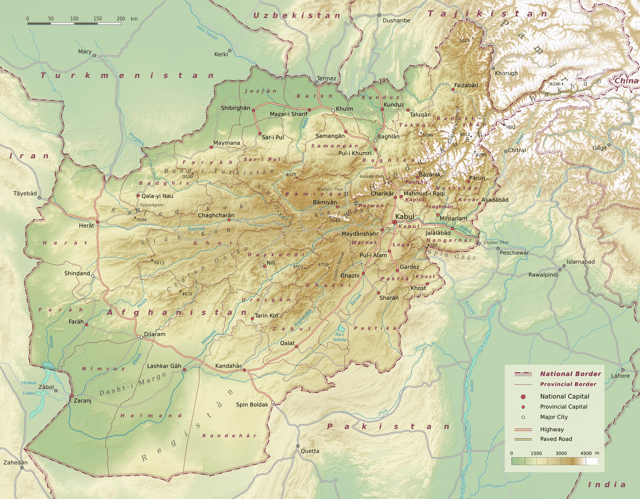
Topography
A landlocked mountainous country with plains in the north and southwest, Afghanistan is located within South Asia[12][145] and Central Asia.[146] The country's highest point is Noshaq, at 7,492 m (24,580 ft) above sea level.[5] It has a continental climate with harsh winters in the central highlands, the glaciated northeast (around Nuristan), and the Wakhan Corridor, where the average temperature in January is below −15 °C (5 °F), and hot summers in the low-lying areas of the Sistan Basin of the southwest, the Jalalabad basin in the east, and the Turkestan plains along the Amu River in the north, where temperatures average over 35 °C (95 °F) in July. The lowest point lies in Jowzjan Province along the Amu River bank, at 258 m (846 ft) above sea level.[5]
Despite having numerous rivers and reservoirs, large parts of the country are dry. The endorheic Sistan Basin is one of the driest regions in the world.[147] Afghanistan receives snow during the winter in the Hindu Kush and Pamir Mountains, and the melting snow in the spring season enters the rivers, lakes, and streams.[148][149] However, two-thirds of the country's water flows into the neighboring countries of Iran, Pakistan, and Turkmenistan. The state needs more than US$2 billion to rehabilitate its irrigation systems so that the water is properly managed.[150]
The northeastern Hindu Kush mountain range, in and around the Badakhshan Province of Afghanistan, is in a geologically active area where earthquakes may occur almost every year.[151] They can be deadly and destructive, causing landslides in some parts or avalanches during the winter.[152] The last strong earthquakes were in 1998, which killed about 6,000 people in Badakhshan near Tajikistan.[153] This was followed by the 2002 Hindu Kush earthquakes in which over 150 people were killed and over 1,000 injured. A 2010 earthquake left 11 Afghans dead, over 70 injured, and more than 2,000 houses destroyed.
The country's natural resources include: coal, copper, iron ore, lithium, uranium, rare earth elements, chromite, gold, zinc, talc, barite, sulfur, lead, marble, precious and semi-precious stones, natural gas, and petroleum, among other things.[154][155] In 2010, US and Afghan government officials estimated that untapped mineral deposits located in 2007 by the US Geological Survey are worth at least $1 trillion.[156]
At over 652,230 km2 (251,830 sq mi),[157] Afghanistan is the world's 41st largest country,[158] slightly bigger than France and smaller than Burma, about the size of Texas in the United States. It borders Pakistan in the south and east; Iran in the west; Turkmenistan, Uzbekistan, and Tajikistan in the north; and China in the far east.[159]
Demographics

Map of major cities as identified by governmental organizations[160]
| Year | Million |
|---|---|
| 1950 | 7.8 |
| 2000 | 20.0 |
| 2019 | 32.2 |
The population of Afghanistan was estimated at 32.2 million in 2019. Of this, 16.4 million are males and 15.8 million females. About 23.9% of them are urbanite, 71.4% live in rural areas, and the remaining 4.7% are nomadic.[6] An additional 3 million or so Afghans are temporarily housed in neighboring Pakistan and Iran, most of whom were born and raised in those two countries. The current population growth rate is 2.37%,[5] the highest in the world outside of Africa. This population is expected to reach 82 million by 2050 if current population trends continue.[162]
The only city with over a million residents is its capital, Kabul. After Kabul the other five large cities are Kandahar, Herat, Mazar-i-Sharif, Kunduz and Jalalabad.[6]
Ethnic groups
Afghanistan's population is divided into several ethnolinguistic groups, which are represented in the ethnolinguistic map and listed in the chart below.
| Ethnic group | Library of Congress 2008 estimate[2] |
|---|---|
| Pashtun | 42% |
| Tajik | 27% |
| Hazara | 9% |
| Uzbek | 9% |
| Aimak | 4% |
| Turkmen | 3% |
| Baloch | 2% |
| others (Pashayi, Nuristani, Pamiri, Arab, etc.) | 4% |
Languages
Dari and Pashto are the official languages of Afghanistan; bilingualism is very common.[1] Dari, which is a variety of and mutually intelligible with Persian (and very often called 'Farsi' by some Afghans like in Iran) functions as the lingua franca in Kabul as well as in much of the northern and northwestern parts of the country.[1] Pashto is the native tongue of the Pashtuns, although many of them are also fluent in Dari while some non-Pashtuns are fluent in Pashto.
Religion
An estimated 99.7% of the Afghan population is Muslim.[5]
| Source | Sunni Islam | Shia Islam | other | just a Muslim | Nothing, do not know, or no answer | |
|---|---|---|---|---|---|---|
| Pew Research Center[166] | 90% | 7% | 0% | 3% | 0% | |
| CIA Factbook (2009 estimate)[5] | 84.7 – 89.7% | 10 – 15% | 0.3% | |||
| Source | Sunni Islam | Imami Shia Islam | Ismaili Shia Islam | other | ||
| Dr Michael Izady[165] | 70% | 25% | 4.5% | 0.5% | ||
Thousands of Afghan Sikhs and Hindus are also found in the major cities.[167][168] There was a small Jewish community in Afghanistan who had emigrated to Israel and the United States by the end of the twentieth century; at least one Jew, Zablon Simintov, remained.[169] Afghan Christians, who number 500–8,000, practice their faith secretly due to intense societal opposition.[170][171]
Governance
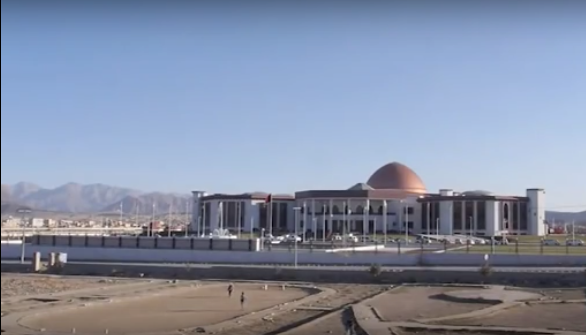
The National Assembly of Afghanistan in 2016
Afghanistan is an Islamic republic consisting of three branches, the executive, legislative, and judicial. The nation is led by President Ashraf Ghani with Abdul Rashid Dostum and Sarwar Danish as vice presidents. Abdullah Abdullah serves as the chief executive officer (CEO). The National Assembly is the legislature, a bicameral body having two chambers, the House of the People and the House of Elders. The Supreme Court is led by Chief Justice Said Yusuf Halem, the former Deputy Minister of Justice for Legal Affairs.[172][173]
Elections and parties
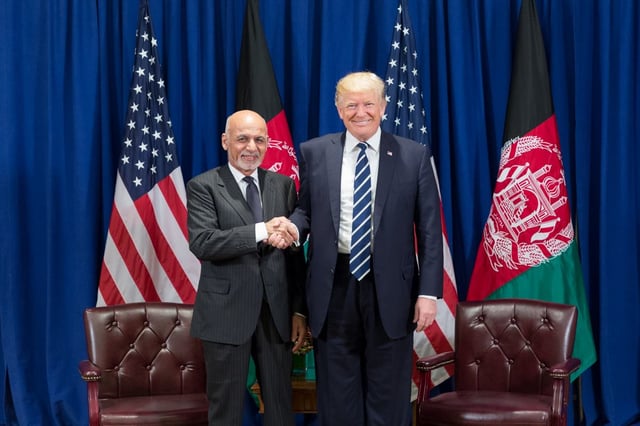
U.S. President Donald Trump with president of Afghanistan Ashraf Ghani in 2017.
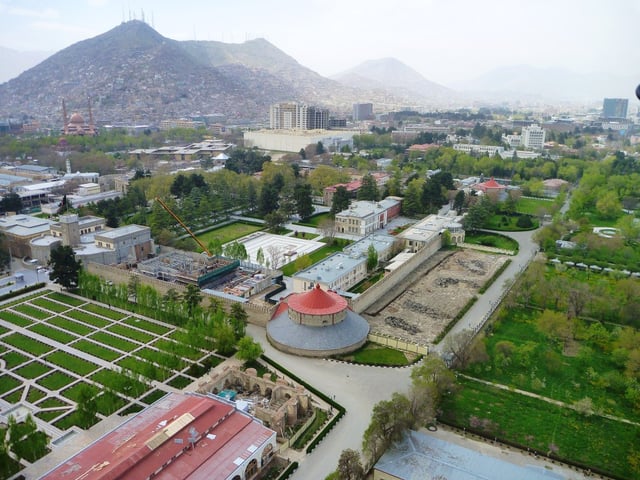
The Arg (Presidential Palace)
One instrument of Afghan governance is the loya jirga (grand assembly), a Pashtun consultative meeting that is mainly organized for choosing a new head of state, adopting a new constitution, or to settle national or regional issue such as war.[176] Loya jirgas have been held since at least 1747,[177] with the most recent one occurring in 2013.[178]
Under the 2004 constitution, both presidential and parliamentary elections are to be held every five years. However, due to the disputed 2014 presidential election, the scheduled 2015 parliamentary elections were delayed until 2018.[179] Presidential elections use the two-round system; if no candidate receives a majority of the vote in the first round, a second round will be held featuring the top two candidates. Parliamentary elections have only one round and are based on the single non-transferable vote system, which allows some candidates to be elected with as little as one percent of the vote.[180]
The 2004 Afghan presidential election was relatively peaceful, in which Hamid Karzai won in the first round with 55.4% of the votes. However, the 2009 presidential election was characterized by lack of security, low voter turnout, and widespread electoral fraud, ending in Karzai's reelection.[181] The 2014 presidential election ended with Ashraf Ghani winning by 56.44% of the votes.[182]
Political parties played a marginal role in post-2001 Afghan politics, in part due to Karzai's opposition to them.[183] In the 2005 parliamentary election, the ballots did not show candidates' party affiliation, so the results were dictated by the personal prestige of the candidates.[183] Among the elected officials were former mujahideen, Islamic fundamentalists, warlords, communists, reformists, and several Taliban associates.[184] In the same period, Afghanistan became the 30th highest nation in terms of female representation in the National Assembly.[185] Parties became more influential after 2009, when a new law established more stringent requirements for party registration.[186] Nearly a hundred new parties were registered after the law came into effect,[187] and party activity increased in the 2014 elections, but party influence remained limited.[188]
Administrative divisions
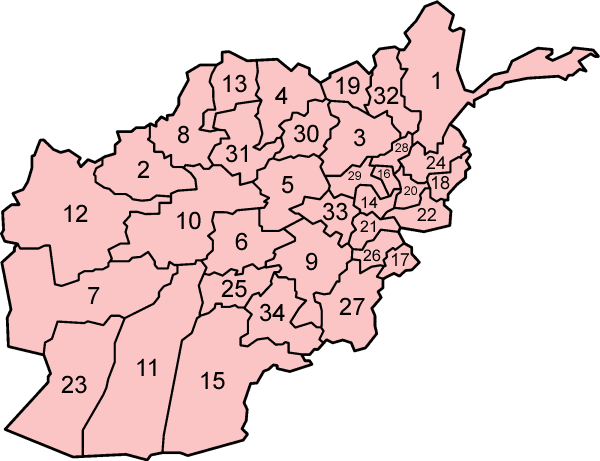
Afghanistan is divided into 34 provinces, which are further divided into a number of districts
Afghanistan is administratively divided into 34 provinces (wilayats).[189] Each province is the size of a U.S. county, having a governor and a capital. The country is further divided into nearly 400 provincial districts, each of which normally covers a city or several villages. Each district is represented by a district governor.
The provincial governors are appointed by the President of Afghanistan, and the district governors are selected by the provincial governors.[190] The provincial governors are representatives of the central government in Kabul and are responsible for all administrative and formal issues within their provinces. There are also provincial councils that are elected through direct and general elections for four years.[191] The functions of provincial councils are to take part in provincial development planning and to participate in the monitoring and appraisal of other provincial governance institutions.
According to article 140 of the constitution and the presidential decree on electoral law, mayors of cities should be elected through free and direct elections for a four-year term. In practice however, mayors are appointed by the government.[192]
The following is a list of all the 34 provinces in alphabetical order:
Badakhshan
Badghis
Baghlan
Balkh
Bamyan
Daykundi
Farah
Faryab
Ghazni
Ghor
Helmand
Herat
Jowzjan
Kabul
Kandahar
Kapisa
Khost
Kunar
Kunduz
Laghman
Logar
Nangarhar
Nimruz
Nuristan
Oruzgan
Paktia
Paktika
Panjshir
Parwan
Samangan
Sar-e Pol
Takhar
Wardak
Zabul
Foreign relations and military

Black Hawks of the Afghan Air Force at Kandahar Airfield. As a major non-NATO ally, the Afghan Armed Forces receive most of their equipment and training from the United States.
Afghanistan became a member of the United Nations in 1946. It enjoys cordial relations with a number of NATO and allied nations, particularly the United States, Canada, United Kingdom, Germany, Australia, and Turkey. In 2012, the United States and Afghanistan signed their Strategic Partnership Agreement in which Afghanistan became a major non-NATO ally.[193] Afghanistan also has friendly diplomatic relations with neighboring China, Iran, Pakistan, Tajikistan, Turkmenistan, and Uzbekistan, including with regional states such as Bangladesh, India, Japan, Kazakhstan, Nepal, Russia, South Korea, the UAE, and so forth. The Afghan Ministry of Foreign Affairs continues to develop diplomatic relations with other countries around the world.
The United Nations Assistance Mission in Afghanistan (UNAMA) was established in 2002 to help the country recover from decades of war.[194] Today, several NATO member states deploy about 17,000 troops in Afghanistan as part of the Resolute Support Mission.[195] Its main purpose is to train the Afghan National Security Forces. The Afghan Armed Forces are under the Ministry of Defense, which includes the Afghan Air Force (AAF) and the Afghan National Army (ANA). The Afghan Defense University houses various educational establishments for the Afghan Armed Forces, including the National Military Academy of Afghanistan.[196]
Law enforcement
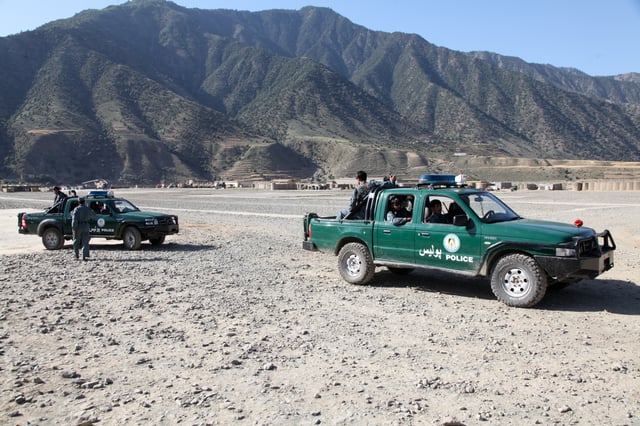
Afghan National Police (ANP) in Kunar Province
Law enforcement in Afghanistan is the responsibility of the Afghan National Police (ANP), which is part of the Ministry of Interior Affairs. The ANP consists of two primary branches, the Afghan Uniformed Police and the Afghan Border Police. The mission of the Uniformed Police is to ensure security within Afghanistan, prevent crime, and protect property. The Border Police is responsible for securing and maintaining the nation's borders with neighboring states as well as all international airports within the country.[197] Afghanistan's intelligence agency, the National Directorate of Security (NDS), assists the ANP with security matters.[198]
All parts of Afghanistan are considered dangerous due to militant activities and terrorism-related incidents. Kidnapping for ransom and robberies are common in major cities. Every year hundreds of Afghan police are killed in the line of duty.[199] Afghanistan is also the world's leading producer of opium.[200] Afghanistan's opium poppy harvest produces more than 90% of illicit heroin globally, and more than 95% of the European supply.[201][202] The Afghan Ministry of Counter Narcotics is responsible for the monitoring and eradication of the illegal drug business.
Economy
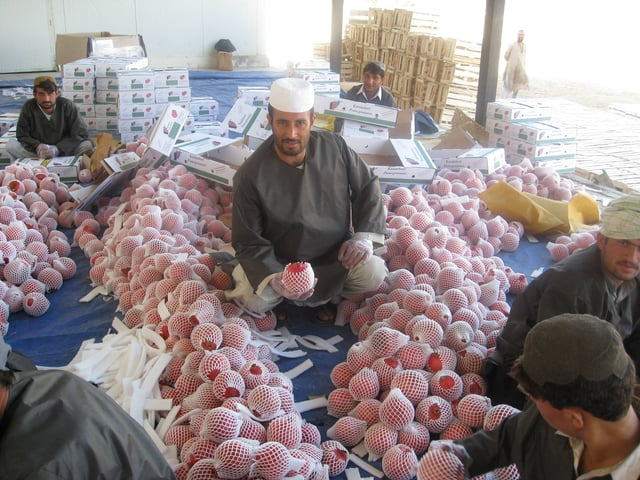
Workers processing pomegranates (anaar), which Afghanistan is famous for in Asia
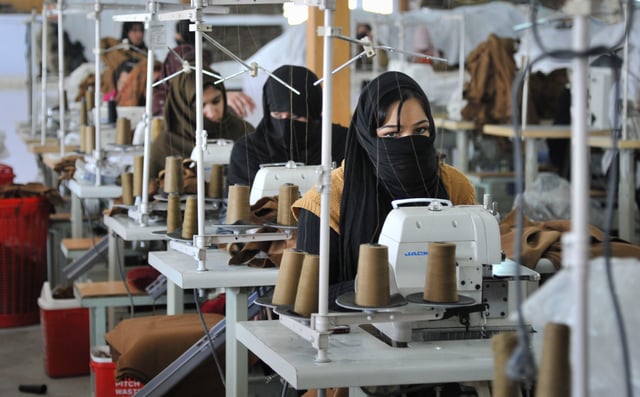
Afghan women at a textile factory in Kabul
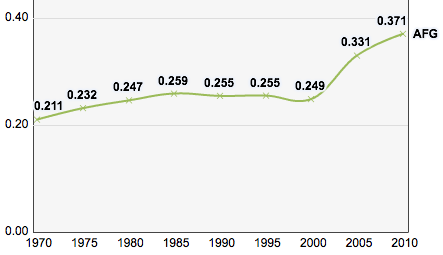
Afghanistan, Trends in the Human Development Index, 1970–2010
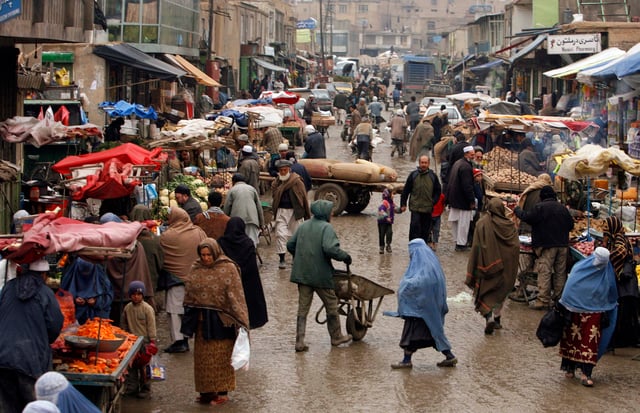
A bustling market street in central Kabul, 2009
Afghanistan's nominal GDP was $21.7 billion in 2018, or $72.9 billion by purchasing power parity (PPP).[7] Its GDP per capita is $2,024 (PPP).[7] Despite having $1 trillion or more in mineral deposits,[206] it remains one of the world's least developed countries. The country imports over $7 billion worth of goods but exports only $784 million, mainly fruits and nuts. It has $2.8 billion in external debt.[5]
Agricultural production is the backbone of Afghanistan's economy.[207] The country is known for producing pomegranates, grapes, apricots, melons, and several other fresh and dry fruits. It is also known as the world's largest producer of opium. As much as 16% or more of the nation's economy is derived from the cultivation and sale of opium.[208]
While the nation's current account deficit is largely financed with donor money, only a small portion is provided directly to the government budget. The rest is provided to non-budgetary expenditure and donor-designated projects through the United Nations system and non-governmental organizations.[209]
Da Afghanistan Bank serves as the central bank of the nation[210] and the "Afghani" (AFN) is the national currency, with an exchange rate of about 75 Afghanis to 1 US dollar.[211] A number of local and foreign banks operate in the country, including the Afghanistan International Bank, New Kabul Bank, Azizi Bank, Pashtany Bank, Standard Chartered Bank, and the First Micro Finance Bank.
One of the main drivers for the current economic recovery is the return of over 5 million expatriates, who brought with them entrepreneurship and wealth-creating skills as well as much needed funds to start up businesses. Many Afghans are now involved in construction, which is one of the largest industries in the country.[212] Some of the major national construction projects include the $35 billion New Kabul City next to the capital, the Aino Mena project in Kandahar, and the Ghazi Amanullah Khan Town near Jalalabad.[213][214][215] Similar development projects have also begun in Herat, Mazar-e-Sharif, and other cities.[216] An estimated 400,000 people enter the labor market each year.[217]
Several small companies and factories began operating in different parts of the country, which not only provide revenues to the government but also create new jobs. Improvements to the business environment have resulted in more than $1.5 billion in telecom investment and created more than 100,000 jobs since 2003.[218] Afghan rugs are becoming popular again, allowing many carpet dealers around the country to hire more workers.
Mining

Lapis lazuli stones
Michael E. O'Hanlon of the Brookings Institution estimated that if Afghanistan generates about $10 billion per year from its mineral deposits, its gross national product would double and provide long-term funding for Afghan security forces and other critical needs.[219] The United States Geological Survey (USGS) estimated in 2006 that northern Afghanistan has an average 460 million m3 (2.9 billion bbl) of crude oil, 440 billion m3 (15.7 trillion cu ft) of natural gas, and 67 billion L (562 million US bbl) of natural gas liquids.[220] In 2011, Afghanistan signed an oil exploration contract with China National Petroleum Corporation (CNPC) for the development of three oil fields along the Amu Darya river in the north.[221]
The country has significant amounts of lithium, copper, gold, coal, iron ore, and other minerals.[154][155][222] The Khanashin carbonatite in Helmand Province contains 1,000,000 tonnes (980,000 long tons; 1,100,000 short tons) of rare earth elements.[223] In 2007, a 30-year lease was granted for the Aynak copper mine to the China Metallurgical Group for $3 billion,[224] making it the biggest foreign investment and private business venture in Afghanistan's history.[225] The state-run Steel Authority of India won the mining rights to develop the huge Hajigak iron ore deposit in central Afghanistan.[226] Government officials estimate that 30% of the country's untapped mineral deposits are worth at least $1 trillion.[156] One official asserted that "this will become the backbone of the Afghan economy" and a Pentagon memo stated that Afghanistan could become the "Saudi Arabia of lithium".[227] In a 2011 news story, the CSM reported, "The United States and other Western nations that have borne the brunt of the cost of the Afghan war have been conspicuously absent from the bidding process on Afghanistan's mineral deposits, leaving it mostly to regional powers."[228]
Transportation
Air
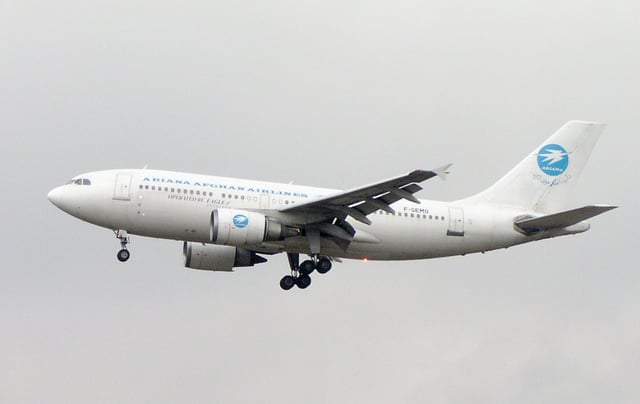
An Ariana Afghan Airlines Airbus A310 in 2006
Air transport in Afghanistan is provided by the national carrier, Ariana Afghan Airlines,[229] and by the private company Kam Air. Airlines from a number of countries also provide flights in and out of the country. These include Air India, Emirates, Gulf Air, Iran Aseman Airlines, Pakistan International Airlines, and Turkish Airlines.
The country has four international airports: Hamid Karzai International Airport (formerly Kabul International Airport), Kandahar International Airport, Herat International Airport, and Mazar-e Sharif International Airport. Including domestic airports, there are 43.[5]
Rail
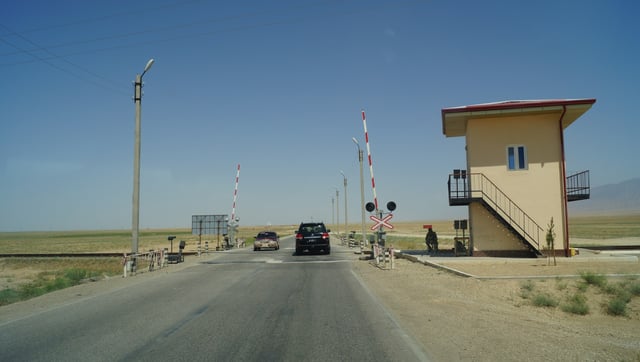
Rail crossing in northern Afghanistan on the line towards Uzbekistan
The country has three rail links: one, a 75-kilometer (47 mi) line from Mazar-i-Sharif to the Uzbekistan border;[230] a 10-kilometer (6.2 mi) long line from Toraghundi to the Turkmenistan border (where it continues as part of Turkmen Railways); and a short link from Aqina across the Turkmen border to Kerki, which is planned to be extended further across Afghanistan.[231] These lines are used for freight only and there is no passenger service. A rail line between Khaf, Iran and Herat, western Afghanistan, intended for both freight and passengers, is under construction as of 2019.[232][233] About 125 kilometers (78 mi) of the line will lie on the Afghan side.[234][235] There are various proposals for the construction of additional rail lines in the country.[236]
Roads
The most important road in Afghanistan is Highway 1, also called the Ring Road, which extends for 2,210 kilometers (1,370 mi) and connects four major cities: Kabul, Ghazni, Kandahar, and Herat.[237] A key portion of Highway 1 is the Salang Tunnel, completed in 1964, which facilitates travel through the Hindu Kush mountain range and connects northern and southern Afghanistan.[238] Traveling by bus in Afghanistan remains dangerous due to militant activities.[239] Serious traffic accidents are common on Afghan roads and highways, particularly on the Kabul–Kandahar and the Kabul–Jalalabad Road.[240]
Health
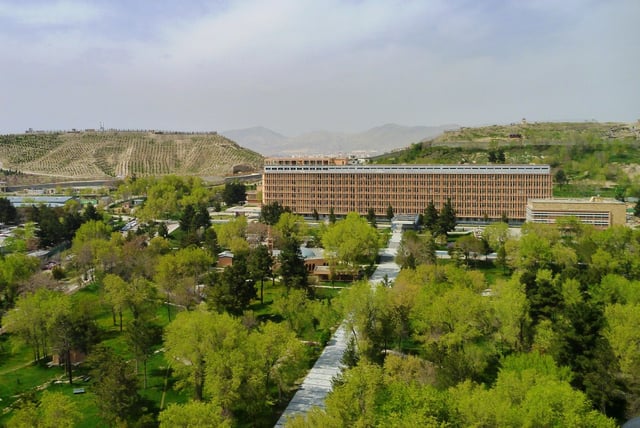
A hospital in Kabul
According to the Human Development Index, Afghanistan is the 15th least developed country in the world. The average life expectancy is estimated to be around 60 years.[241][242] The country's maternal mortality rate is 396 deaths/100,000 live births and its infant mortality rate is 66[242] to 112.8 deaths in every 1,000 live births.[5] The Ministry of Public Health plans to cut the infant mortality rate to 400 for every 100,000 live births before 2020. The country has more than 3,000 midwives, with an additional 300 to 400 being trained each year.[243]
There are over 100 hospitals in Afghanistan,[244] with the most advanced treatments being available in Kabul. The French Medical Institute for Children and Indira Gandhi Children's Hospital in Kabul are the leading children's hospitals in the country. Some of the other leading hospitals in Kabul include the Jamhuriat Hospital and Jinnah Hospital.[245] In spite of all this, many Afghans travel to Pakistan and India for advanced treatment.
It was reported in 2006 that nearly 60% of the Afghan population lives within a two-hour walk of the nearest health facility.[246] Disability rate is also high in Afghanistan due to the decades of war.[247] It was reported recently that about 80,000 people are missing limbs.[248][249] Non-governmental charities such as Save the Children and Mahboba's Promise assist orphans in association with governmental structures.[250] Demographic and Health Surveys is working with the Indian Institute of Health Management Research and others to conduct a survey in Afghanistan focusing on maternal death, among other things.[251]
Education
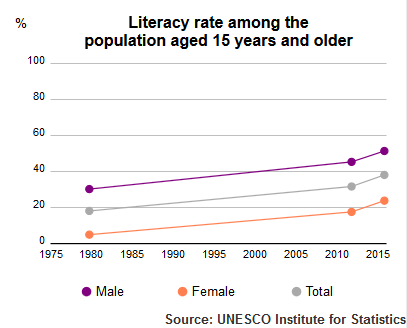
UNESCO Institute of Statistics Afghanistan Literacy Rate population plus15 1980–2015
Education in Afghanistan includes K–12 and higher education, which is overseen by the Ministry of Education and the Ministry of Higher Education. There are over 16,000 schools in the country and roughly 9 million students. Of this, about 60% are males and 40% females. Over 174,000 students are enrolled in different universities around the country. About 21% of these are females.[252] Former Education Minister Ghulam Farooq Wardak had stated that construction of 8,000 schools is required for the remaining children who are deprived of formal learning.[253]
The top universities in Afghanistan are the American University of Afghanistan (AUAF) followed by Kabul University (KU), both of which are located in Kabul. The National Military Academy of Afghanistan, modeled after the United States Military Academy at West Point, is a four-year military development institution dedicated to graduating officers for the Afghan Armed Forces. The Afghan Defense University was constructed near Qargha in Kabul. Major universities outside of Kabul include Kandahar University in the south, Herat University in the northwest, Balkh University and Kunduz University in the north, Nangarhar University and Khost University in the east. The United States is building six faculties of education and five provincial teacher training colleges around the country, two large secondary schools in Kabul, and one school in Jalalabad.[252]
Culture
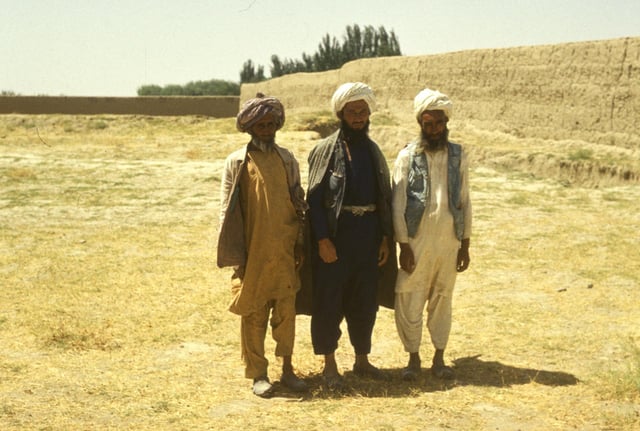
Men wearing traditional Afghan (Pashtun) dress in Faryab Province

Ethnic Tajik girls in traditional clothing in Mazar-i-Sharif
Afghanistan is a predominantly tribal society, with different regions of the country having their own cultures. In the southern and eastern region, the people live according to the Pashtun culture by following Pashtunwali (the Pashtun way).[255] Key tenets of Pashtunwali include hospitality, the provision of sanctuary to those seeking refuge, and revenge for the shedding of blood.[256] The Pashtuns (and Baloch) are largely connected to the culture of South Asia. The remaining Afghans are culturally Persian and Turkic. Some non-Pashtuns who live in proximity with Pashtuns have adopted Pashtunwali in a process called Pashtunization, while some Pashtuns have been Persianized. Those who have lived in Pakistan and Iran over the last 30 years have been further influenced by the cultures of those neighboring nations.
Afghans, particularly Pashtuns, are noted for their tribal solidarity and high regard for personal honor.[257] One writer considers the tribal system to be the best way of organizing large groups of people in a country that is geographically difficult, and in a society that, from a materialistic point of view, has an uncomplicated lifestyle.[258] There are various Afghan tribes, and an estimated 2–3 million nomads.[259] Afghan culture is deeply Islamic,[260] but pre-Islamic practices persist.[261] One example is bacha bazi, a term for activities involving sexual relations between older men and younger adolescent men, or boys.[262]
The nation has a complex history that has survived either in its current cultures or in the form of various languages and monuments. However, many of its historic monuments have been damaged in modern times.[263] The two famous Buddhas of Bamiyan were destroyed by the Taliban, who regarded them as idolatrous. Despite that, archaeologists are still finding Buddhist relics in different parts of the country, some of them dating back to the 2nd century.[264][265] This indicates that Buddhism was widespread in Afghanistan. Other historical places include the cities of Herat, Kandahar, Ghazni, Mazar-i-Sharif, and Zaranj. The Minaret of Jam in the Hari River valley is a UNESCO World Heritage site. A cloak reputedly worn by Islam's prophet Muhammad is kept inside the Shrine of the Cloak in Kandahar, a city founded by Alexander and the first capital of Afghanistan. The citadel of Alexander in the western city of Herat has been renovated in recent years and is a popular attraction for tourists. In the north of the country is the Shrine of Ali, believed by many to be the location where Ali was buried.[266] The National Museum of Afghanistan is located in Kabul.
Women
According to Global Rights, almost 90% of women in Afghanistan experience physical abuse, sexual abuse, psychological abuse or forced marriage. The perpetrators of these crimes are the families of the victim.[267] A 2009 proposal for a law against the violence of women could only be passed through a presidential decree.[267]
In 2012, Afghanistan recorded 240 cases of honor killing, but the total number is believed to be much higher. Of the reported honor killings, 21% were committed by the victims’ husbands, 7% by their brothers, 4% by their fathers, and the rest by other relatives.[268][269]
Media and entertainment
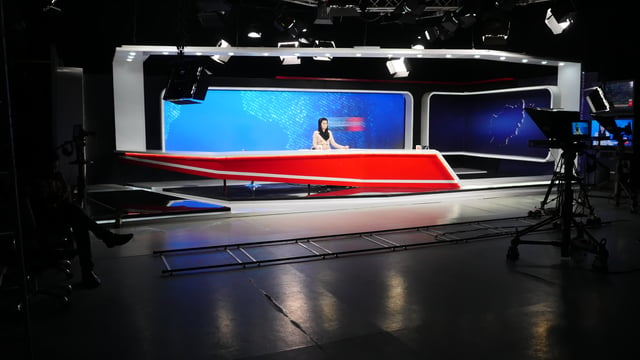
Studio of TOLOnews in Kabul
Afghanistan has around 350 radio stations and over 200 television stations.[273] which includes the state-owned RTA TV and various private channels such as TOLO and Shamshad TV. The first Afghan newspaper was published in 1906,[274] and there are hundreds of print outlets today.[273] By the 1920s, Radio Kabul was broadcasting local radio services.[275] Television programs began airing in the early 1970s. Voice of America, BBC, and Radio Free Europe/Radio Liberty (RFE/RL) broadcast in both of Afghanistan's official languages.[276]
Since 2002, press restrictions have been gradually relaxed and private media diversified. Freedom of expression and the press is promoted in the 2004 constitution, and censorship is banned, although defaming individuals or producing material contrary to the principles of Islam is prohibited. In 2019, Reporters Without Borders listed the media environment of Afghanistan as 121st out of 179 on its Press Freedom Index, with 1st being most free.[277][278]
The city of Kabul has been home to many musicians who were masters of both traditional and modern Afghan music. Traditional music is especially popular during the Nowruz (New Year) and National Independence Day celebrations. Ahmad Zahir, Nashenas, Ustad Sarahang, Sarban, Ubaidullah Jan, Farhad Darya, and Naghma are some of the notable Afghan musicians, but there are many others.[279] Afghans have long been accustomed to watching Indian Bollywood films and listening to its filmi songs. Many Bollywood film stars have roots in Afghanistan, including Salman Khan, Saif Ali Khan, Shah Rukh Khan, Aamir Khan, Feroz Khan, Kader Khan, Naseeruddin Shah, Zarine Khan, Celina Jaitly, and a number of others. Several Bollywood films have been shot inside Afghanistan, including Dharmatma, Khuda Gawah, Escape from Taliban, and Kabul Express.
Communication
Telecommunication services in Afghanistan are provided by Afghan Telecom, Afghan Wireless, Etisalat, MTN Group, and Roshan. The country uses its own space satellite called Afghansat 1, which provides services to millions of phone, internet, and television subscribers. By 2001 following years of civil war, telecommunications was virtually a non-existent sector, but by 2016 it had grown to a $2 billion industry, with 22 million mobile phone subscribers and 5 million internet users. The sector employs at least 120,000 people nationwide.[280]
Cuisine
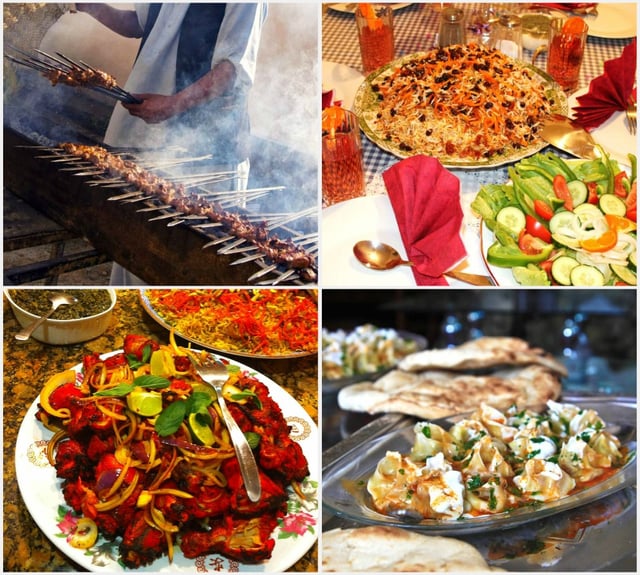
Some of the popular Afghan dishes
Afghan cuisine is largely based upon the nation's chief crops, such as wheat, maize, barley and rice. Accompanying these staples are native fruits and vegetables as well as dairy products such as milk, yogurt and whey. Kabuli palaw is the national dish of Afghanistan.[281] The nation's culinary specialties reflect its ethnic and geographic diversity.[282] Afghanistan is known for its high quality pomegranates, grapes, and sweet melons.[283]
Poetry
Classic Persian and Pashto poetry are a cherished part of Afghan culture. Thursdays are traditionally "poetry night" in the city of Herat when men, women and children gather and recite both ancient and modern poems.[284] Poetry has always been one of the major educational pillars in the region, to the level that it has integrated itself into culture. Some notable poets include Rumi, Rabi'a Balkhi, Sanai, Jami, Khushal Khan Khattak, Rahman Baba, Khalilullah Khalili, and Parween Pazhwak.[285]
Sports
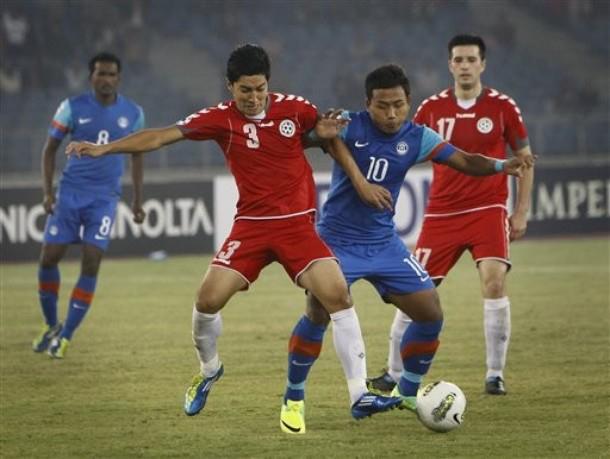
The Afghanistan national football team (in red uniforms) before its first win over India (in blue) during the 2011 SAFF Championship.
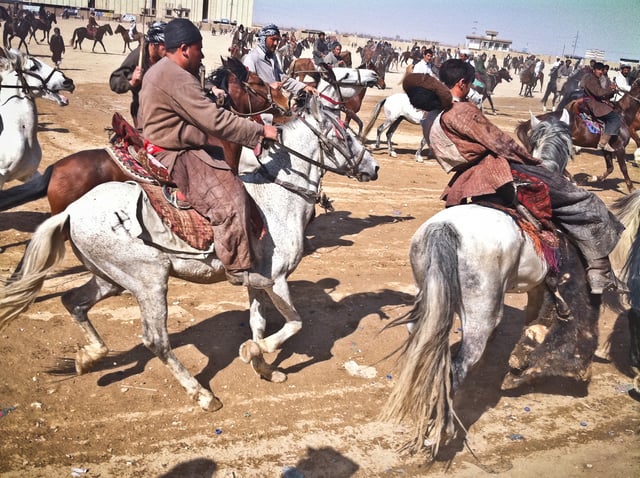
The traditional national sport of Afghanistan, Buzkashi
Sport in Afghanistan is managed by the Afghan Sports Federation. Cricket and association football are the two most popular sports in the country.[286][287] The Afghan Sports Federation promotes cricket, association football, basketball, volleyball, golf, handball, boxing, taekwondo, weightlifting, bodybuilding, track and field, skating, bowling, snooker, chess, and other sports.
Afghanistan's sports teams are increasingly celebrating titles at international events. Its basketball team won the first team sports title at the 2010 South Asian Games.[288] Later that year, the country's cricket team followed as it won the 2009–10 ICC Intercontinental Cup.[289] In 2012, the country's 3x3 basketball team won the gold medal at the 2012 Asian Beach Games. In 2013, Afghanistan's football team followed as it won the SAFF Championship.[290]
The Afghan national cricket team, which was formed in 2001, participated in the 2009 ICC World Cup Qualifier, 2010 ICC World Cricket League Division One and the 2010 ICC World Twenty20. It won the ACC Twenty20 Cup in 2007, 2009, 2011 and 2013. The team eventually made it and played in the 2015 Cricket World Cup.[291] The Afghanistan Cricket Board (ACB) is the official governing body of the sport and is headquartered in Kabul. The Alokozay Kabul International Cricket Ground serves as the nation's main cricket stadium. There are several other stadiums throughout the country, including the Ghazi Amanullah Khan International Cricket Stadium near Jalalabad. Domestically, cricket is played between teams from different provinces.
The Afghanistan national football team has been competing in international football since 1941.[292] The national team plays its home games at the Ghazi Stadium in Kabul, while football in Afghanistan is governed by the Afghanistan Football Federation. The national team has never competed or qualified for the FIFA World Cup but has recently won an international football trophy in 2013.[290] The country also has a national team in the sport of futsal, a 5-a-side variation of football.
The traditional and the national sport of Afghanistan is buzkashi, mainly popular among the northern Afghans. It is similar to polo, played by horsemen in two teams, each trying to grab and hold a goat carcass.[293] The Afghan Hound (a type of running dog) originated in Afghanistan and was formerly used in wolf hunting. In 2002, traveler Rory Stewart reported that dogs were still used for wolf hunting in remote areas.[294]
See also
Index of Afghanistan-related articles
Outline of Afghanistan
References
- "U.S. maps". Pubs.usgs.gov. Archived from the original on 25 December 2013. Retrieved 19 May 2012. "South Asia: Data, Projects, and Research". Retrieved 2 March 2015. "MAPS SHOWING GEOLOGY, OIL AND GAS FIELDS AND GEOLOGICAL PROVINCES OF SOUTH ASIA (Includes Afghanistan)". Retrieved 2 March 2015. "University of Washington Jackson School of International Studies: The South Asia Center". Archived from the original on 2 April 2015. Retrieved 2 March 2015. "Syracruse University: The South Asia Center". Retrieved 2 March 2015. "Center for South Asian studies". Retrieved 2 March 2015.



